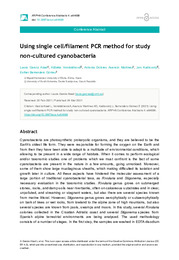Resumen :
Cyanobacteria are photosynthetic prokaryotic organisms, and they are believed to be the
Earth’s oldest life form. They were responsible for forming the oxygen on the Earth and
from then they have been able to adapt to a multitude of environmental conditions, which
allowing to be present in a wide range of habitats. When it comes to perform ecological
and/or taxonomic studies one of problems which we must confront is the fact of some
cyanobacteria are present in the nature in a few amounts, going unnoticed. Moreover,
some of them show large mucilaginous sheaths, which making difficulted its isolation and
growth later in culture. All these aspects have hindered the molecular assessment of a
large portion of traditional cyanobacterial taxa, as Rivularia and Stigonema, especially
necessary evaluation in the taxonomic studies. Rivularia genus grows on submerged
stones, rocks, and damp soils near riverbanks, often on calcareous substrates and in clear,
unpolluted, and streaming or stagnant waters, but also there are several species known
from marine littoral. However, Stigonema genus grows aerophytically or subaerophytically
on bark of trees or wet rocks, from lowland to the alpine zone of high mountains, but also
several species are known from pools, swamps and moors. In this study, several Rivularia
colonies collected in the Croatian Adriatic coast and several Stigonema species from
Spanish alpine terrestrial environments are being analysed. The used methodology
consists of a number of stages. In the first step, the samples are washed in EDTA disodium
‡ § ‡ §
‡
© García Abad L et al. This is an open access article distributed under the terms of the Creative Commons Attribution License (CC
BY 4.0), which permits unrestricted use, distribution, and reproduction in any medium, provided the original author and source are
credited.
salt solution for dissolving the associated of calcium carbonate deposits (STEP 1). For the
isolation of single cells and filaments, we are using a modified single filament isolation
technique for planktonic cyanobacteria applying a glass capillary under sterile conditions
(Zapomělová et al. 2008) described by Mareš et al. 2015 (STEP 2). Then, an optimized
protocol we are utilized for amplification of the 16S rRNA gene, the associated 16S–23S
internal transcribed spacer (ITS) region and the partially the 23S rRNA gene (2,000-2,500
bp) (Berrendero et al. 2016) (STEP 3). Finally, sequences analysis will carry out to
determine the phylogenetic position of the different genotypes found inside a same
Rivularia colony to be able to relation them with the morphotypes observed by the
microscope. In the case of the Stigonema samples, we have successfully gotten the
isolation of several filaments and, at the present, we are working on the amplification the
studied region. This methodology, based on a glass capillary isolation technique and a
PCR protocol for amplification of specific sequences, has been applied with success in the
Rivularia and Stigonema samples without the need to cultivate them. Our future research
will focus on the amplification of several taxonomic marker genes at the same time.
|

 La licencia se describe como: Atribución-NonComercial-NoDerivada 4.0 Internacional.
La licencia se describe como: Atribución-NonComercial-NoDerivada 4.0 Internacional.
.png)